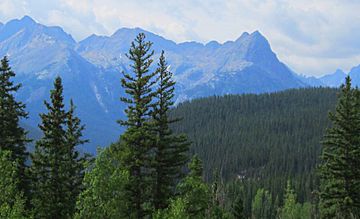Needle Mountains facts for kids
Quick facts for kids Needle Mountains |
|
|---|---|

Needle Mountains seen from the San Juan Skyway.
|
|
| Highest point | |
| Peak | Mount Eolus |
| Elevation | 14,089 ft (4,294 m) |
| Dimensions | |
| Length | 54 mi (87 km) N-S |
| Width | 21 mi (34 km) E-W |
| Area | 728 sq mi (1,890 km2) |
| Geography | |
| Country | United States |
| State | Colorado |
| Parent range |
|
The Needle Mountains are a subrange of the San Juan Mountains of the Rocky Mountains located in the southwestern part of the U.S. State of Colorado. Much of the range is protected in the Weminuche Wilderness of the San Juan National Forest. The range is notable for having some of the most rugged mountains in the state, and includes many technical climbs and scrambles. A small but dramatic east-west subrange in the northern section is known as the Grenadier Range.
Geology
Unlike the rest of the San Juan Mountains, which are volcanic in origin, the Needle Mountains (along with the Grenadier Range) are a mass of uplifted Precambrian rocks. They consist chiefly of quartzite, granite, and amphibolite. The mountains are referred to as the Needle Mountains Uplift.
Notable peaks
- Mount Eolus, 14,089 ft
- Windom Peak, 14,082 ft
- Sunlight Peak, 14,059 ft
- Pigeon Peak, 13,972 ft
- Vestal Peak, 13,864 ft (Grenadier Range)
- Turret Peak, 13,835 ft
- Jagged Mountain, 13,824 ft
- Arrow Peak, 13,803 ft (Grenadier Range)
- Animas Mountain, 13,786 ft
- Storm King Peak, 13,752 ft (Grenadier Range)
- Mount Silex, 13,628 ft
- The Guardian (Colorado), 13,617 ft
- Leviathan Peak, 13,528 ft
- Vallecito Mountain, 13,428 ft
- Mount Garfield, 13,074 ft

